Huon Valley Council
| Huon Valley Council | |||||||||||||
|---|---|---|---|---|---|---|---|---|---|---|---|---|---|
|
Huon Valley Council (Macquarie Island not shown on map) | |||||||||||||
| Coordinates | 43°12′0″S 146°43′48″E / 43.20000°S 146.73000°ECoordinates: 43°12′0″S 146°43′48″E / 43.20000°S 146.73000°E | ||||||||||||
| Population | 15,140 (2011 census)[1] | ||||||||||||
| • Density | 2.7542/km2 (7.1334/sq mi) | ||||||||||||
| Established | 1993 | ||||||||||||
| Area | 5,497 km2 (2,122.4 sq mi) | ||||||||||||
| Mayor | Peter Coad[2] | ||||||||||||
| Council seat | Huonville | ||||||||||||
| Region | Huonville, Huon Valley, and Macquarie Island | ||||||||||||
| State electorate(s) | Franklin | ||||||||||||
| Federal Division(s) | Franklin | ||||||||||||
| Website | Huon Valley Council | ||||||||||||
| |||||||||||||
The Huon Valley Council is a local government area of Tasmania. It is the southernmost local government area in Australia. It encompasses the town of Huonville, on the Huon River, some surrounding towns, and many protected areas and forestry plantations. The Tahune Airwalk is also in the area, located near the township of Geeveston.
History
The name of the Huon is derived from Jean-Michel Huon de Kermadec, a 18th century French explorer wo was 2nd in command to Antoine Bruni d'Entrecasteaux, who navigated the area. The Huon Valley, Huonville, Huon River, Huon Pine, Port Huon, Glen Huon and the Electoral division of Huon are all named for him. The former Municipality of Esperance was named for his ship.[3]
In 1993 the Municipalities of Esperance, Huon and Port Cygnet were amalgamated to form the Huon Valley Council. Remote subantarctic Macquarie Island, which is located some 1400 km southeast of Tasmania proper, was part of Esperance until then, and has been part of Huon Valley since then.
Demographics
The municipality has eight townships and numerous rural suburbs
Politics
For election purposes, Huon Valley is un-subdivided. Councillors serve divided four year terms, with elections every two years using the Hare-Clark system of proportional representation. The terms of four Councillors expire at one two yearly election, and the terms of five Councillors expire at the other. The Mayor and Deputy Mayor are each directly elected for a two-year term. The Mayor and Deputy Mayor must also be elected Councillors. Unless a non-retiring Councillor they are ineligible to hold the position of Mayor or Deputy Mayor if they fail to win election to a Councillor position as well. The current composition of the Council, with place of residence, is:[4]
- Mayor for a term expiring 2013: Robert Armstrong (Cygnet)
- Deputy Mayor for a term expiring 2013: Mike Wilson (Port Huon)
Elected 2011 for a term expiring 2015:
- Robert Armstrong (Cygnet)
- Liz Smith (Cygnet)
- Peter Pepper (Geeveston)
- Ian Paul (Judbury)
Elected 2009 for a term expiring 2013:
- Bruce Heron (Grove)
- Mike Wilson (Port Huon)
- Tony Duggan (Huonville)
- Rohan Gudden (Cygnet)
- Rosalie Woodruff (Cygnet)
Neither the Australian Labor Party nor the Liberal Party of Australia endorse local government candidates in Tasmania. Most Councillors are non-partisan. Two Councillors, Liz Smith and Rosalie Woodruff, are members of the Australian Greens.[5]
According to ABS data, the townships in the South East that experienced the largest growth were Huonville (including Franklin where the population was up by 1,300 people) with Cygnet third (up for 440).
References
- ↑ "2011 Census QuickStats - Huon Valley (LGA)". Australian Bureau of Statistics. 2011. Retrieved 3 November 2014.
- ↑ "Local council polls: Sue Hickey elected Hobart Lord Mayor over Damon Thomas". Yahoo. 29 October 2014. Retrieved 3 November 2014.
- ↑ "Huon". electoral.tas.gov.au. Electoral Council of Tasmania. Retrieved 28 December 2014.
- ↑ http://www.huonvalley.tas.gov.au/site/page.cfm?u=353
- ↑ http://www.tasmaniantimes.com/index.php/article/huon-valley-guessing-games-12
Further reading
- Tyson, Nell. and Rushton, Annie (1995) Family bushwalks in Tasmania’s Huon valley Dover, Tas.: Driftwood Publishing. ISBN 0-646-26155-X
External links
| ||||||||||||||||||||||||||||
